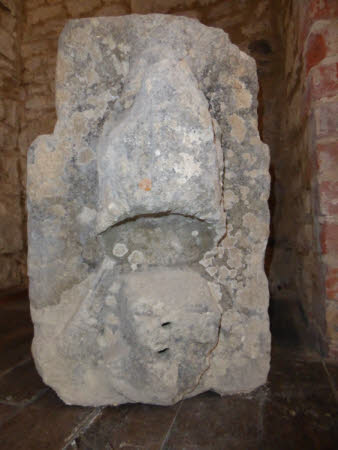Relief carving
Category
Architecture / Features & Decoration
Date
1219 - 1547
Materials
Measurements
5.6 x 3.8 x 2.3 cm
Order this imageCollection
Horton Court, Gloucestershire
NT 740404
Summary
A limestone sculpture of a bishop’s mitre in relief believed to have been a decorative feature of the main house. The exact date of the piece, and who it represents is still unknown.
Full description
This is a limestone sculpture of a bishop’s mitre in three-quarter relief. It is 560 mm high, 380 mm wide and 230 mm deep; the upper 140 mm is joggled with an offset of 40 mm. The interior is hollowed out as with a real mitre. The depiction is realistic, with the two tassels decorated with embroidery and with fringes on their ends. The upper part of the mitre is pointed and has a vertical column of what may be embroidery meeting the two columns on the sides, together forming a broad arrow shape. Where the head would be is a small shield, now very worn and difficult to see, which bears a broad cross on it. The upright post of the cross contains two small dowel holes, set vertically, presumably to locate a wooden or metal figure of Christ. This piece of sculpture is now freestanding in the garden but it was recorded in 1895 as being built into the churchyard wall where it was set along with the 1492 datestone and the 1521 Knight inscription. They were presumably removed from their original settings and reset in the wall by one of the Pastons following their major re-arrangement of the property in the 18th-century. The other two stones have since been built back into the fabric of the house, this has not as it is not a straightforward ashlar block. It presumably came from the manor house and not the church, possibly from the dismantled oriel, Knight’s private oratory. Harcourt, (2010), Conservation Management Plan Gazetteer v.5, National Trust
Provenance
Indigenous 12th - 15th century feature of Horton Court, bequeathed to the National Trust by Hilda Wills in 1947.
